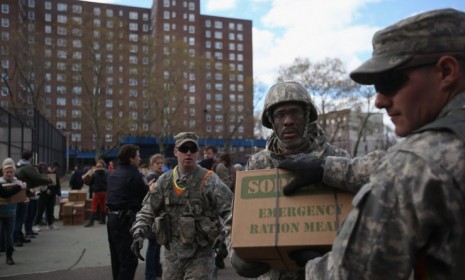Hurricane Sandy: New York's 'massive, massive housing problem'
As many as 40,000 New Yorkers need a new place to stay, and the city doesn't have a lot of housing to spare

The floodwaters have long receded and the lights are flickering back on in many parts of the New York City area struck by Superstorm Sandy, but that doesn't mean everything's rosy. Temperatures are dropping toward freezing levels, about 1.9 million customers in the region are still without power — roughly half in New Jersey — and up to 40,000 New Yorkers need a new place to stay, New York City Mayor Michael Bloomberg said Sunday, in a joint appearance with Gov. Andrew Cuomo (D-N.Y.). "This is going to be a massive, massive housing problem," Cuomo added. Here's a look at this looming post-Sandy concern, and what's being done to solve it:
Who are these 40,000 newly homeless people?
There are several groups of people in New York and New Jersey who will need new homes, at least temporarily — single-family homeowners in Staten Island, coastal Queens, and the Jersey Shore whose houses are waterlogged or destroyed, for example, and residents who don't have gas or electricity to heat themselves safely as the freezing temperatures hit — but the biggest group is people in public housing. Bloomberg said 40,000 is the worst possible case, as estimated by the Department of Housing and Urban Development, and that a more realistic number is 20,000 people displaced by Sandy, most of whom live in New York's housing projects. About 400,000 New Yorkers live in public housing, and many of the projects are near the water — including in hard-hit areas like Brooklyn's Red Hook and Coney Island neighborhoods. In some of those high-rise buildings, the situation is getting dire.
The Week
Escape your echo chamber. Get the facts behind the news, plus analysis from multiple perspectives.

Sign up for The Week's Free Newsletters
From our morning news briefing to a weekly Good News Newsletter, get the best of The Week delivered directly to your inbox.
From our morning news briefing to a weekly Good News Newsletter, get the best of The Week delivered directly to your inbox.
Where will these residents go?
It's not clear. New York City has opened up heating shelters; the Federal Emergency Management Agency (FEMA) said over the weekend that it will provide hotel rooms for up to two weeks for people whose homes are not habitable, and some people will get rental assistance for temporary apartments. "We are not going to let anybody go sleeping in the streets or go without blankets," Bloomberg said, but at the same time, "we don't have a lot of empty housing in this city," and areas like Staten Island don't have an abundance of hotels or empty apartments. FEMA chief Craig Fugate said if states request them, his agency is ready to supply trailers for people to live in temporarily, as FEMA did after Hurricane Katrina. "It has got to make sense for the neighborhood," he added. "We are going to bring all potential housing solutions and look at what works best for each neighborhood."
If people didn't evacuate before the storm, will they leave now?
There's certainly some residual resistance to the idea. "People aren't leaving their homes," Staten Island resident Tara Saylor, 25, told CNN. "They have no place to go." Some residents don't have family or friends to stay with in safer areas, some who do have no way to reach them, and others are just scared. But with a cold front — and another nor'easter forecast to hit mid-week — staying put could be a death sentence, officials warned. "You can die from being cold," Bloomberg said, and also from trying to warm your home though improvised methods like turning on gas or propane stoves. "People are in homes that are uninhabitable," Cuomo added. "It's increasingly clear they are uninhabitable when the temperature drops and the heat doesn't go on."
A free daily email with the biggest news stories of the day – and the best features from TheWeek.com
How long will the power be out?
Most utilities said all electricity would be restored by Nov. 10, although the hardest-hit parts of the Jersey Shore and the Rockaways, in Queens, might have to wait a few days longer. The nor'easter could complicate repairs, too. Cuomo, Bloomberg, and New Jersey Gov. Chris Christie (R-N.J.) have all noted pointedly that they are watching the publicly regulated utilities to make sure they deliver, but Sandy has unleashed the greatest devastation ever faced by the area's power industry, Brian Wolff of industry group Edison Electric Institute tells Bloomberg. With hundreds of thousands of customers without power, and a cold front descending, this week is critical. Things are bad in the areas officials and the media have turned the spotlight on, Sen. Kirsten Gillibrand (D-N.Y.) tells CNN. But "what I'm most concerned about right now are the people we haven't met and we haven't seen."
Sources: Bloomberg, CNN, New York Daily News, The New York Times (2)
-
 US citizens are carrying passports amid ICE fears
US citizens are carrying passports amid ICE fearsThe Explainer ‘You do what you have to do to avoid problems,’ one person told The Guardian
-
 All roads to Ukraine-Russia peace run through Donetsk
All roads to Ukraine-Russia peace run through DonetskIN THE SPOTLIGHT Volodymyr Zelenskyy is floating a major concession on one of the thorniest issues in the complex negotiations between Ukraine and Russia
-
 Why is Trump killing off clean energy?
Why is Trump killing off clean energy?Today's Big Question The president halts offshore wind farm construction